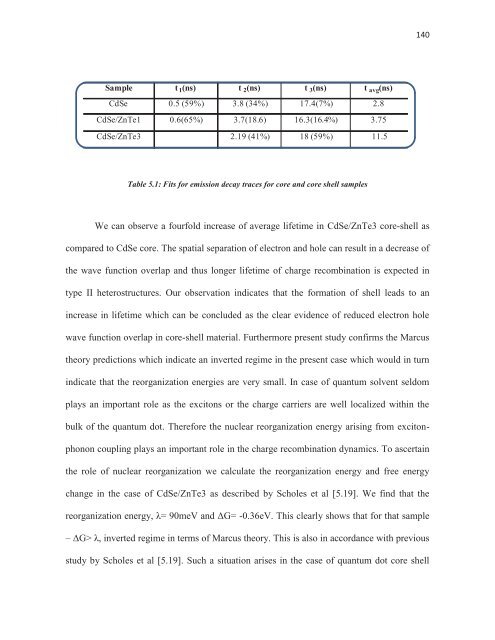CHEM01200604009 Sreejith Kaniyankandy - Homi Bhabha ...
CHEM01200604009 Sreejith Kaniyankandy - Homi Bhabha ...
CHEM01200604009 Sreejith Kaniyankandy - Homi Bhabha ...
You also want an ePaper? Increase the reach of your titles
YUMPU automatically turns print PDFs into web optimized ePapers that Google loves.
140<br />
Sample t 1 (ns) t 2 (ns) t 3 (ns) t avg (ns)<br />
CdSe 0.5 (59%) 3.8 (34%) 17.4(7%) 2.8<br />
CdSe/ZnTe1 0.6(65%) 3.7(18.6) 16.3(16.4%) 3.75<br />
CdSe/ZnTe3 2.19 (41%) 18 (59%) 11.5<br />
Table 5.1: Fits for emission decay traces for core and core shell samples<br />
We can observe a fourfold increase of average lifetime in CdSe/ZnTe3 core-shell as<br />
compared to CdSe core. The spatial separation of electron and hole can result in a decrease of<br />
the wave function overlap and thus longer lifetime of charge recombination is expected in<br />
type II heterostructures. Our observation indicates that the formation of shell leads to an<br />
increase in lifetime which can be concluded as the clear evidence of reduced electron hole<br />
wave function overlap in core-shell material. Furthermore present study confirms the Marcus<br />
theory predictions which indicate an inverted regime in the present case which would in turn<br />
indicate that the reorganization energies are very small. In case of quantum solvent seldom<br />
plays an important role as the excitons or the charge carriers are well localized within the<br />
bulk of the quantum dot. Therefore the nuclear reorganization energy arising from excitonphonon<br />
coupling plays an important role in the charge recombination dynamics. To ascertain<br />
the role of nuclear reorganization we calculate the reorganization energy and free energy<br />
change in the case of CdSe/ZnTe3 as described by Scholes et al [5.19]. We find that the<br />
reorganization energy, λ= 90meV and ΔG= -0.36eV. This clearly shows that for that sample<br />
– ΔG> λ, inverted regime in terms of Marcus theory. This is also in accordance with previous<br />
study by Scholes et al [5.19]. Such a situation arises in the case of quantum dot core shell
















